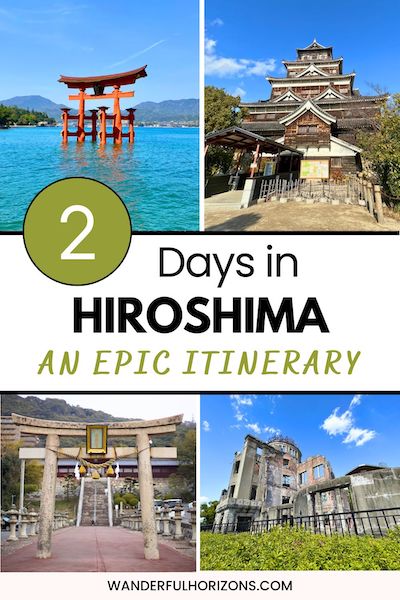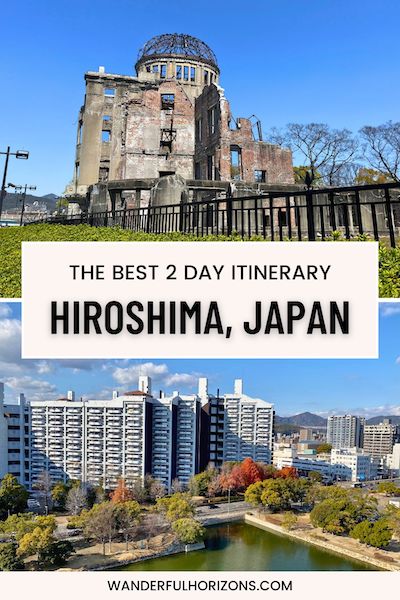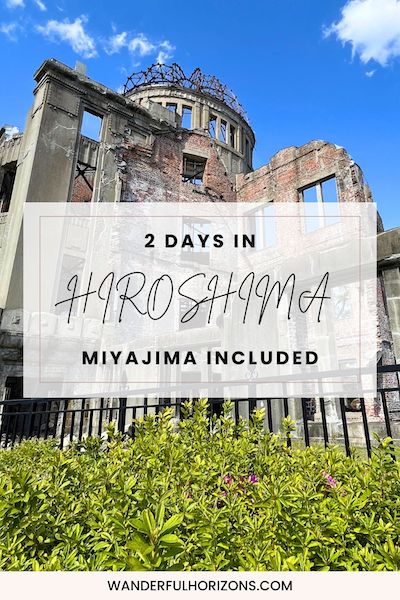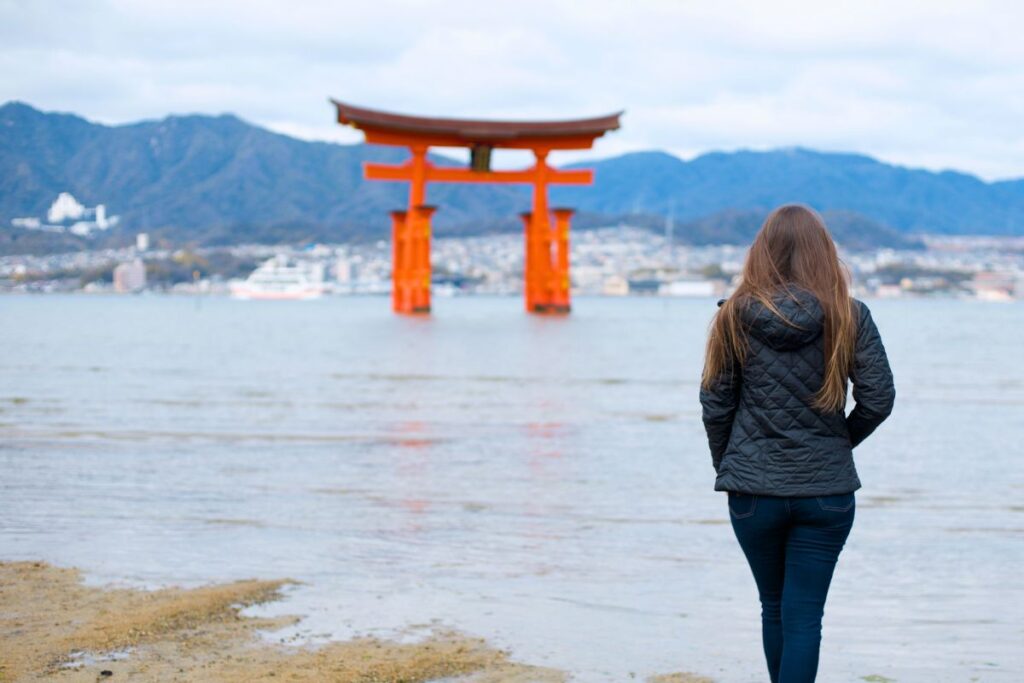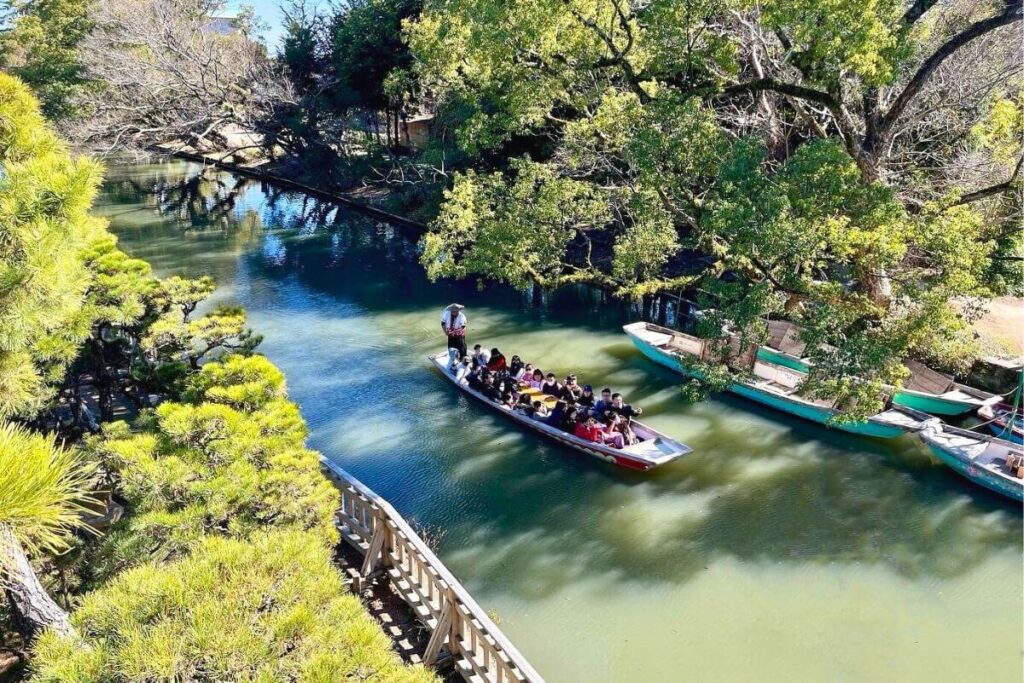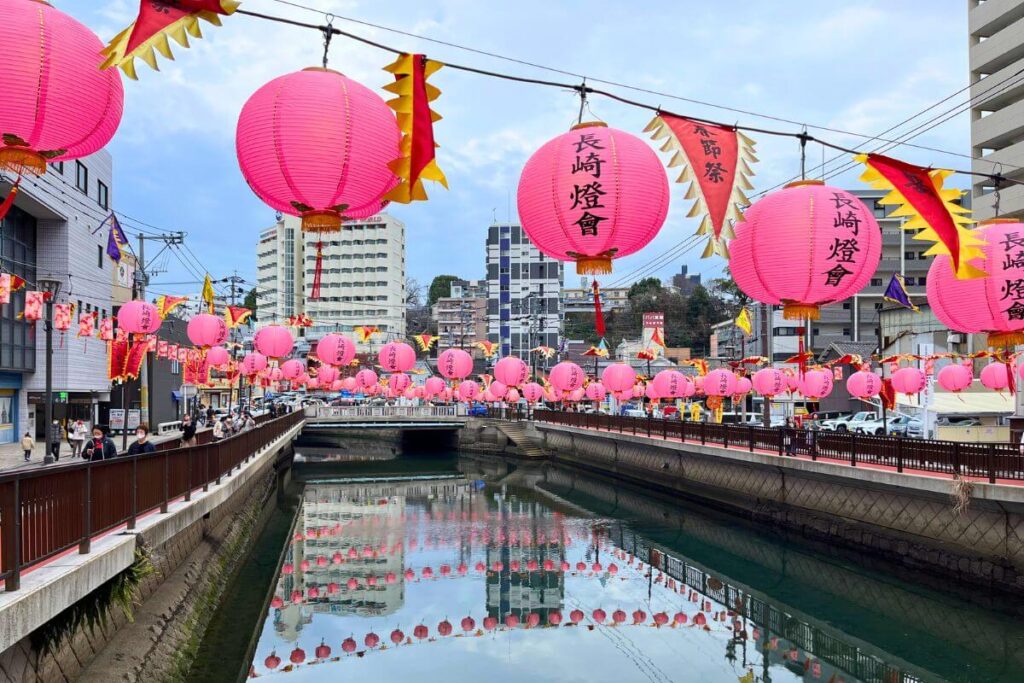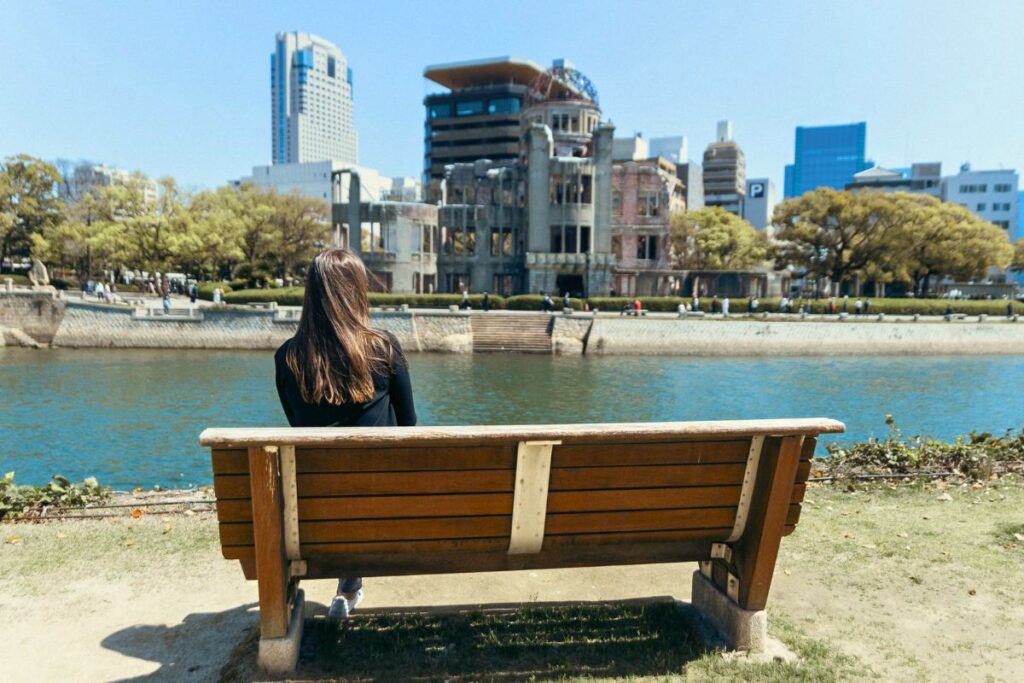
Last updated on May 1, 2024 by Krysti
Are you in search of the perfect Hiroshima itinerary? Then look no further! Because I’ve got you covered with the ultimate guide to 2 days in Hiroshima!
While Hiroshima is often associated with the tragedy it endured during WWII, this modern-day city is actually a vibrant, flourishing metropolis – one that is quickly gaining popularity among the travel community. And for good reason!
Known for its scenic coastal views, small-town vibes, historical landmarks, delectable local cuisine, and culturally rich community, Hiroshima certainly has a lot to offer!
So much so, that I’ve gone back on several occasions and always seem to find something new to explore.
Factor in the popular nearby destination of Miyajima Island, and your options here are endless!
But what happens if you only have 2 days to explore the city? Where should you go? What should you do?
Don’t worry, we’ll discuss all of this and more as we plan out the ultimate Hiroshima itinerary for 2 days.
Best Time to Visit Hiroshima
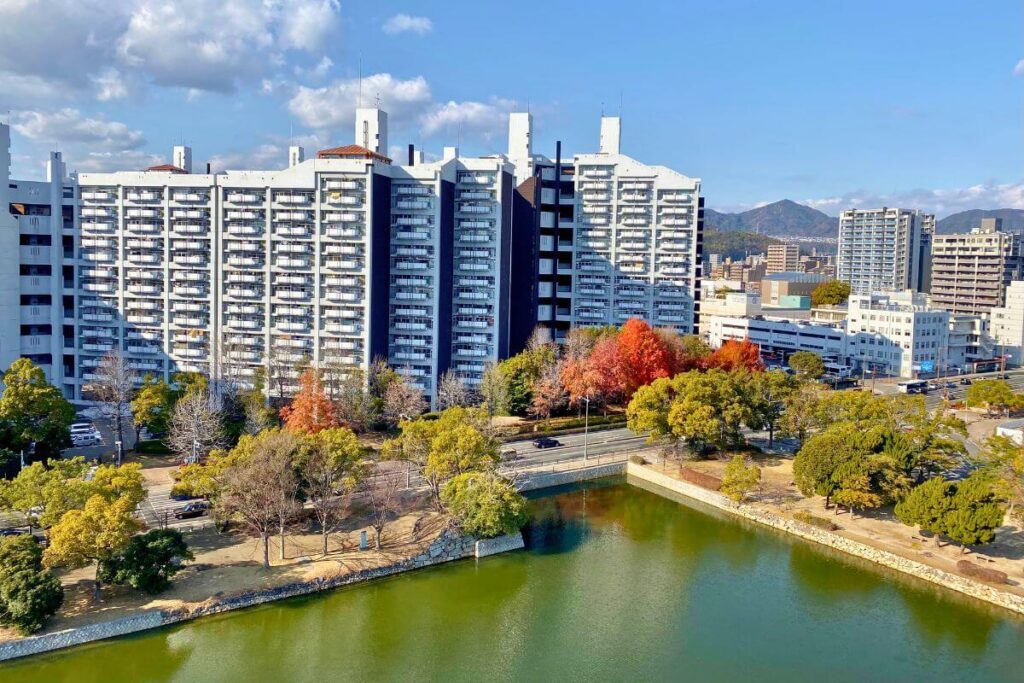
Truth be told, Hiroshima is a great destination to visit any time of the year! While some seasons are a bit prettier (think spring and fall), every season offers its own benefits and perks.
Here’s a quick breakdown for you to compare!
Spring: Like most of Japan, spring in Hiroshima is known for its sakura season. Cherry blossoms here tend to bloom around the end of March or the beginning of April, although this can vary depending on the weather. While this time of year is very beautiful, it’s also peak travel season – so be prepared for crowds!
Summer: Although summer is on the warmer side, it’s not unbearably hot in Hiroshima like it is in other Japanese cities. Given Hiroshima’s location along the coast, summer days can actually be quite pleasant. Especially if you spend your days exploring the city’s numerous seaside parks and beaches! Just be aware that summer does bring with it quite a bit of rain. So, it’s best to have a few rainy-day activities in mind.
Fall: Hiroshima is just as pretty in the fall as it is in the spring. This is thanks to the city’s abundant maple trees, which blanket the landscape in vibrant colors. Miyajima Island in particular is quite beautiful this time of the year. That being said, fall is also a popular time to travel in Japan, so you can expect to encounter larger crowds.
Winter: Temperatures may drop, but it’s not overwhelmingly cold in Hiroshima during the winter. Sure, you’ll want to bundle up, but it’s certainly manageable. And well worth the effort, because there are significantly fewer crowds around this time of the year. On top of this, the city hosts a variety of holiday festivals and Christmas markets that are worth checking out!
A Note on Japanese Holidays
Japan has a few major national holidays that significantly impact travel. These include Golden Week (end of April – beginning of May), Silver Week (mid-September), and New Years.
Around these holiday periods, domestic travel peaks, prices increase significantly, and businesses may temporarily close down. Given this, I generally recommend, if at all possible, that visitors avoid travel to Japan during these times.
How to Get to Hiroshima
The city of Hiroshima is located in Hiroshima Prefecture along the southeastern coast of Honshu, Japan’s largest island.
For those flying in, the closest airport to the city is Hiroshima Airport (HIJ), which is located about an hour northeast in Mihara.
To get from the airport to downtown Hiroshima you can take a taxi or catch a ride on the city’s airport limousine bus.
Alternatively, there’s also a shuttle bus that provides transportation to Shiraichi Station. From here you can then catch a train into the city.
If you’re traveling by train within Japan, the main station for the city (and the only one to service Shinkansen bullet trains) is Hiroshima Station.
How to Get Around Hiroshima
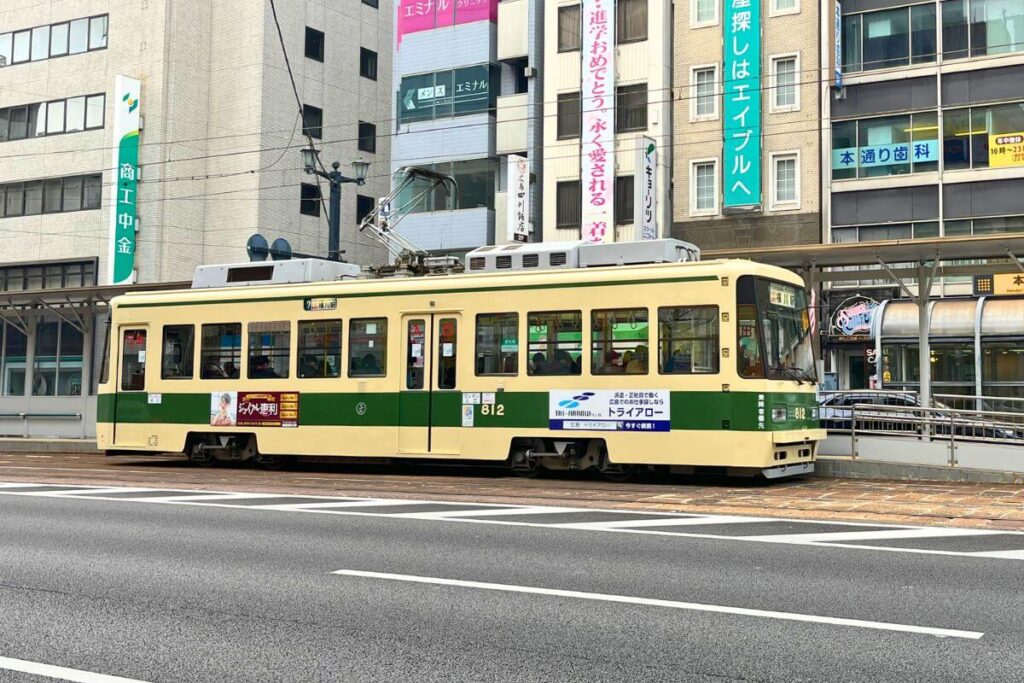
Trams are a common mode of public transportation in Hiroshima.
Although Hiroshima is a major metropolis, it’s still quite easy to get around.
The city offers an extensive network of trams and buses that you can utilize. And, on top of this, many popular attractions and amenities are within walking distance from the downtown area.
To access the public transportation system in Hiroshima, it’s best to purchase an IC card, which is essentially a transportation pass.
These prepaid, refillable cards can be found at many train stations and airports. Or they can be downloaded directly to your Apple wallet, if you have an iPhone.
Unfortunately, this feature is not yet available on Android phones.
IC cards are compatible with most forms of public transportation throughout Japan. This means they can be used on trams, buses, trains, and subways in Hiroshima, as well as in Tokyo, Osaka, Fukuoka, Kyoto, etc.
Some exceptions to this, however, include Shinkansen (or bullet trains), limited express trains, and highway buses. These forms of transportation typically require their own separate ticket.
Pro Tip: Download Google Maps and use it to help you navigate the city. This app is one of the best navigation apps for Japan, as it syncs with local public transportation and provides accurate, up-to-date transit information.
Hiroshima, Japan Map
To help you get a lay of the land, here’s a map overview of all the places mentioned in this 2 day Hiroshima itinerary.
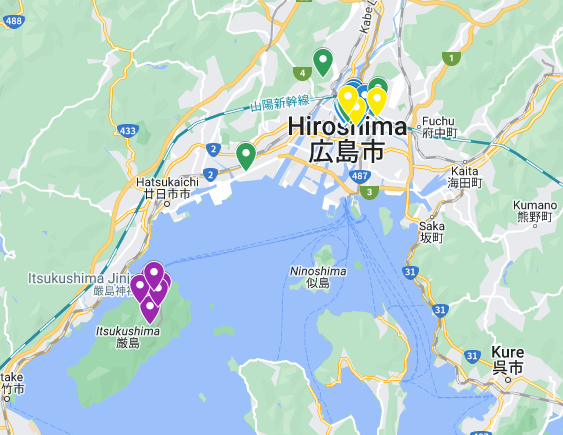
If you’d like to view an interactive version of this map, click here!
2 Days in Hiroshima: An Overview
Don’t have time to read the article in full? Here’s a quick recap of my suggested itinerary for 2 days in Hiroshima.
- Day 1 – Hiroshima City Highlights: Visit the Hiroshima Peace Memorial Museum, Peace Memorial Park, and the Atomic Bomb Dome. Grab okonomiyaki for lunch or take a cooking class. Stop by Hiroshima Castle and Shukkeien Garden.
- Day 2 – Miyajima Island: Discover Itsukushima Shrine and behold its floating torii gate. Stop by the Five-Storied Pagoda. Take in the views from Mount Misen Observatory and visit Daisho-in Temple. Explore the shops on Miyajima Island.
2 Days in Hiroshima: Explained
On that note, let’s dive in and discuss in detail the perfect 2 day itinerary for Hiroshima. I’ve included numerous options for you to consider, as well as some alternative activities. Feel free to pick and choose and adapt this itinerary as you see fit!
Day 1: Hiroshima City Highlights
Your first day in Hiroshima will focus mainly on the city’s top highlights. I recommend dedicating your morning to the Hiroshima Peace Memorial Museum and Peace Park. Then, from there, you can venture off and explore some of the other local attractions.
Visit the Hiroshima Peace Memorial Museum
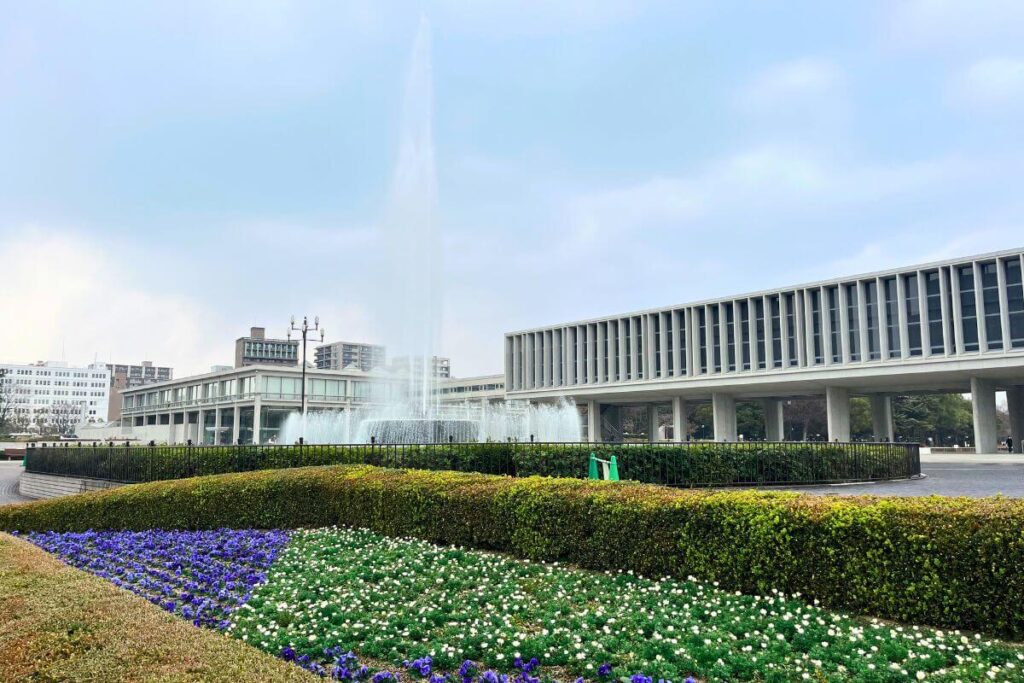
On August 6, 1945, at approximately 8:15 am, Hiroshima became the first city in the world to ever experience the impact of an atomic bomb.
It’s not clear how many people were directly affected by this, but some sources estimate that as many as 237,000 people were either killed or injured.
In memory of this tragic event, the city of Hiroshima founded the Hiroshima Peace Memorial Museum.
Within its walls, you’ll find several exhibits detailing the bombing of the city, what followed in the aftermath, and what’s being done to prevent the future use of nuclear weapons.
The experience is definitely a difficult and sobering one, but important nonetheless.
If you’ve never had the chance to do so, I highly recommend touring an atomic bomb museum – either here in Hiroshima or in Nagasaki (the second Japanese city to be bombed).
Reflect at Hiroshima Peace Memorial Park
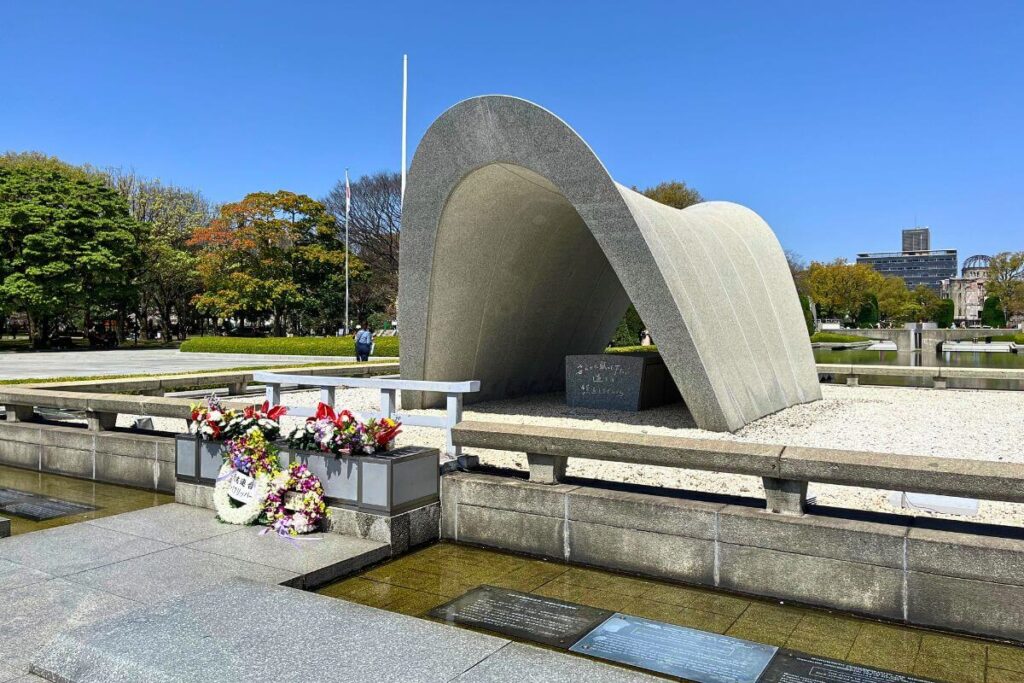
The Hiroshima Victims Memorial Cenotaph in the Peace Memorial Park.
Outside of the Peace Memorial Museum, you’ll find the Hiroshima Peace Memorial Park.
Created in remembrance of the nuclear attack that destroyed the city, the park features a variety of important and meaningful monuments.
Some of the most notable include the Hiroshima Victims Memorial Cenotaph, where you’ll find the names of all known bombing victims inscribed.
There’s also the Children’s Peace Monument, which is meant to honor the children who died during the nuclear attack.
As well as the Flame of Peace, an open flame that has been continuously burning since it was lit on August 1, 1964.
This flame is meant to serve as a form of protest against nuclear weapons. And is set to remain lit until all atomic bombs have been eradicated from Earth.
See the Atomic Bomb Dome
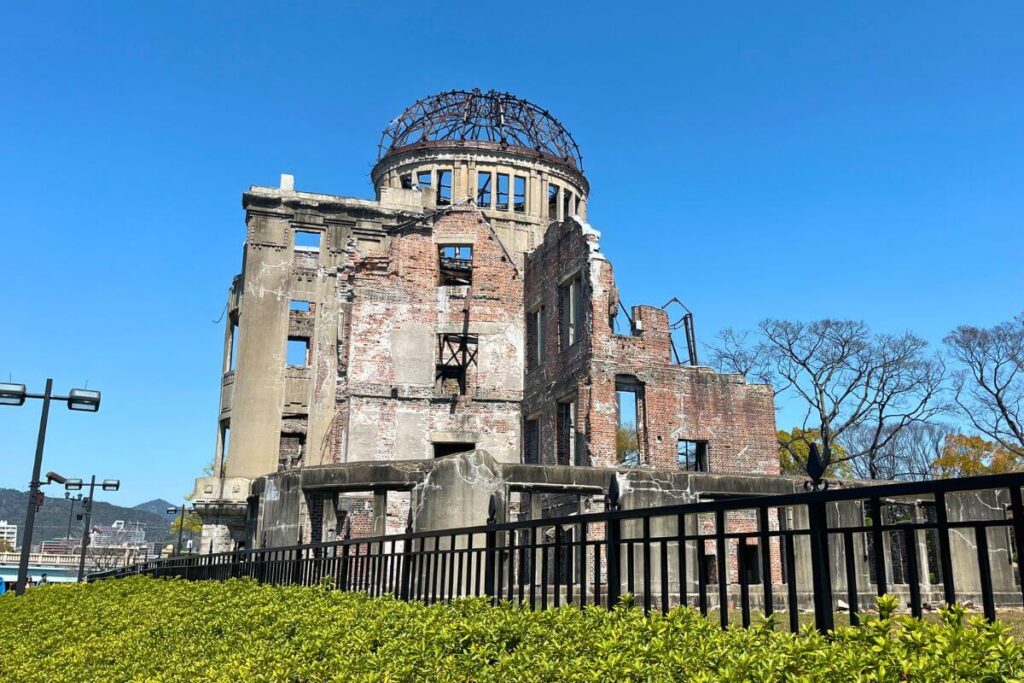
Within the Hiroshima Peace Memorial Park, lies another very important landmark – the Atomic Bomb Dome.
A UNESCO World Heritage Site in and of itself, the dome was the only structure left standing near the hypocenter after the atomic bomb exploded in 1945.
The building sustained significant damage but was never repaired.
Instead, it remains untouched, serving as a warning and a reminder of the catastrophic consequences of nuclear war.
Pro Tip: For a bird’s eye view of the Atomic Bomb Dome head over to the observation deck at Hiroshima Orizuru Tower.
Sample Okonomiyaki
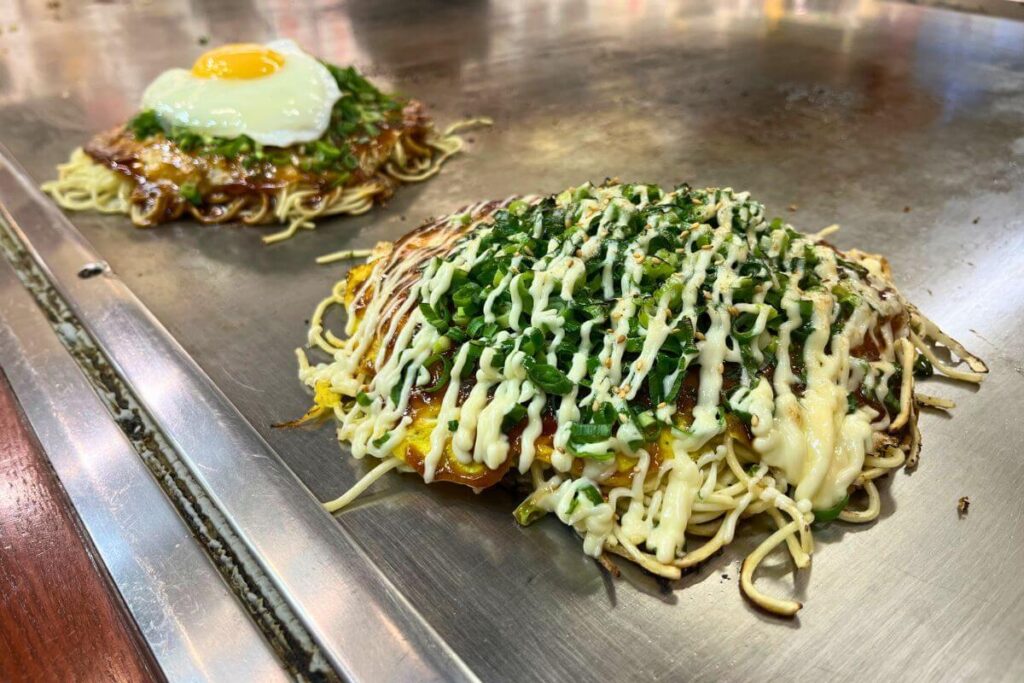
If you only had time to eat one thing in Hiroshima, make sure it’s okonomiyaki!
This savory pancake-like dish (when served Hiroshima-style) features layers of batter, yakisoba noodles, cabbage, pork belly, and green onions – all drizzled in special okonomiyaki sauce.
Optional toppings are also available and include additions such as fried eggs, mayo, and pickled ginger, among others.
It may sound like a strange combination, but trust me – it works and it’s delicious!
One of the best places to try okonomiyaki is at Okonomi mura Suigun, also known as the Okonomiyaki Village.
Here, you’ll find three floors full of different okonomiyaki vendors – each offering their own personal twist on this popular dish.
Or, alternatively, you can sign up for an okonomiyaki cooking class and learn how to make it for yourself.
I’ve taken friends to do this and we had a great time cooking and eating our very own okonomiyaki!
Discover Hiroshima Castle
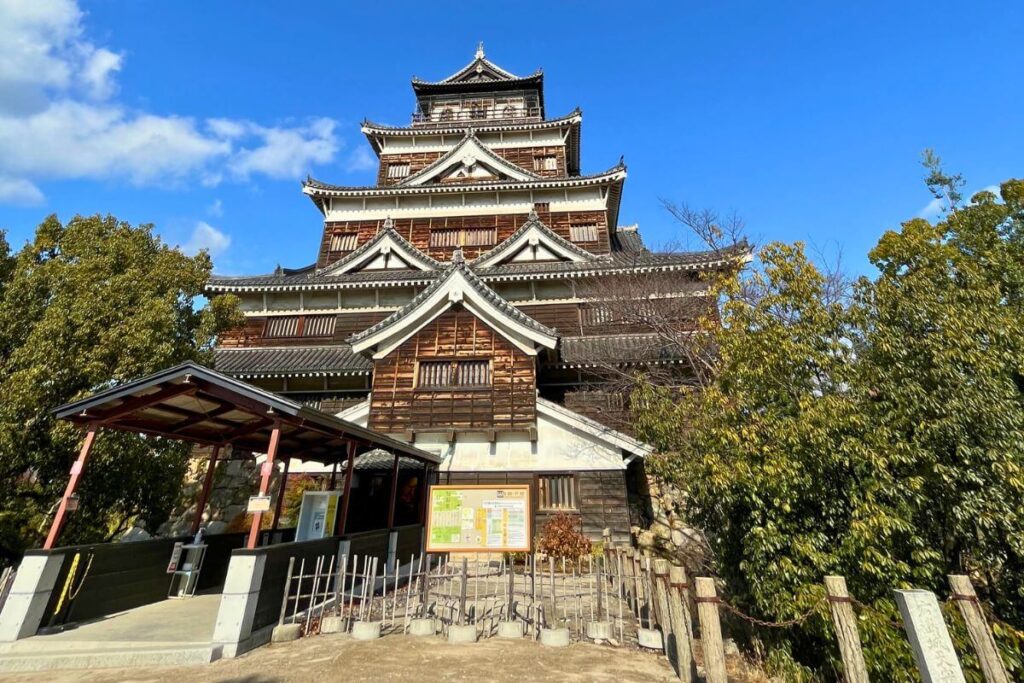
Built during the 17th century, Hiroshima Castle was, at one point in time, a vital seat of power in Japan.
Unfortunately, however, the original castle was destroyed during the bombing of the city in the 1940s.
Today, what remains is a reconstructed replica that features several exhibits detailing the history of the castle and the feudal lords who once ruled there.
Also on the property, you’ll find the Hiroshima Gokoku Shrine. This Shinto Shrine, which is one of the most popular in the region, is known for its New Year’s festivals.
Pro Tip: Be sure to climb to the top of the castle tower for incredible views of the city!
Explore Shukkeien Garden
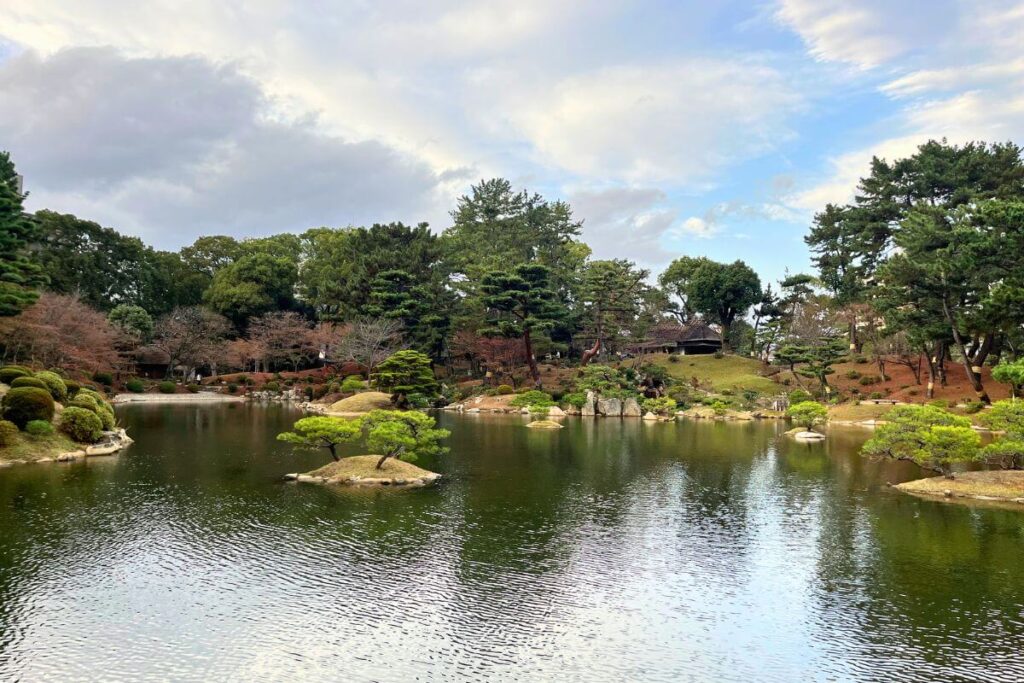
If you have time to spare, head on over to Shukkeien Garden, which is located just around the corner from Hiroshima Castle.
Dating back more than 400 years, this historic garden once belonged to the feudal lords of Hiroshima.
While it was destroyed by the atomic bomb, the garden has since been restored to reflect its original appearance.
The garden is a particularly popular destination in the spring, as it’s home to several different kinds of blossoming cherry trees.
Day 2: Miyajima Island Excursion
On your second day, we’ll venture outside of the city and visit Miyajima Island. To get here, you’ll either hop on a ferry in Hiroshima or take the train down to Miyajimaguchi Station, where you’ll find the JR ferry terminal.
🌟 For more detailed directions on how to get to Miyajima and what to do while you’re there, be sure to check out my guide to Miyajima Island!
Admire the Floating Torii Gate
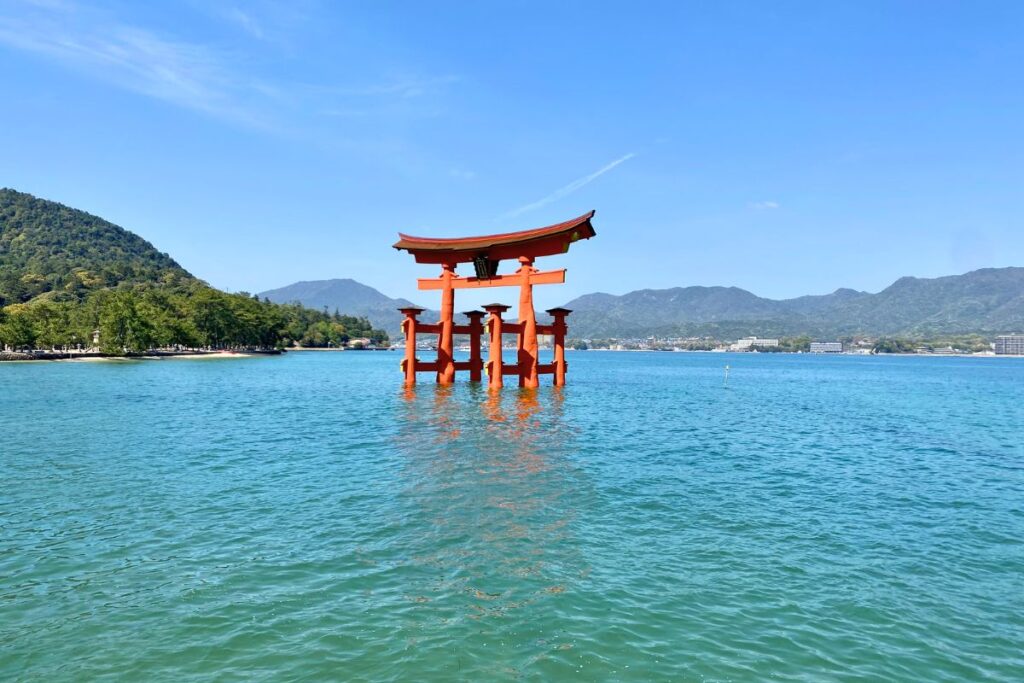
Without a doubt, Miyajima’s most famous attraction is the grand torii gate that lies just off its shores.
Serving as the sacred entrance to Itsukushima Shrine, this imposing red-orange gate measures 16.8 meters in height and is set against the backdrop of Hiroshima Bay.
Depending upon your arrival time, you’ll have the chance to experience the torii gate at either high tide or low tide – both of which offer incredible experiences.
During high tide, the gate is surrounded by water and appears to almost float on the surface.
Meanwhile, low tide grants access to the beach and offers visitors the opportunity to see the torii gate up close and personal.
Pro Tip: As you make your way over to the torii gate, be on the lookout for deer! Miyajima is home to a wild, yet tame population of sika deer. These deer can be found all across the island – and are always on the hunt for food. So, be sure to keep snacks and treats out of reach or they may get stolen!
Visit Itsukushima Shrine
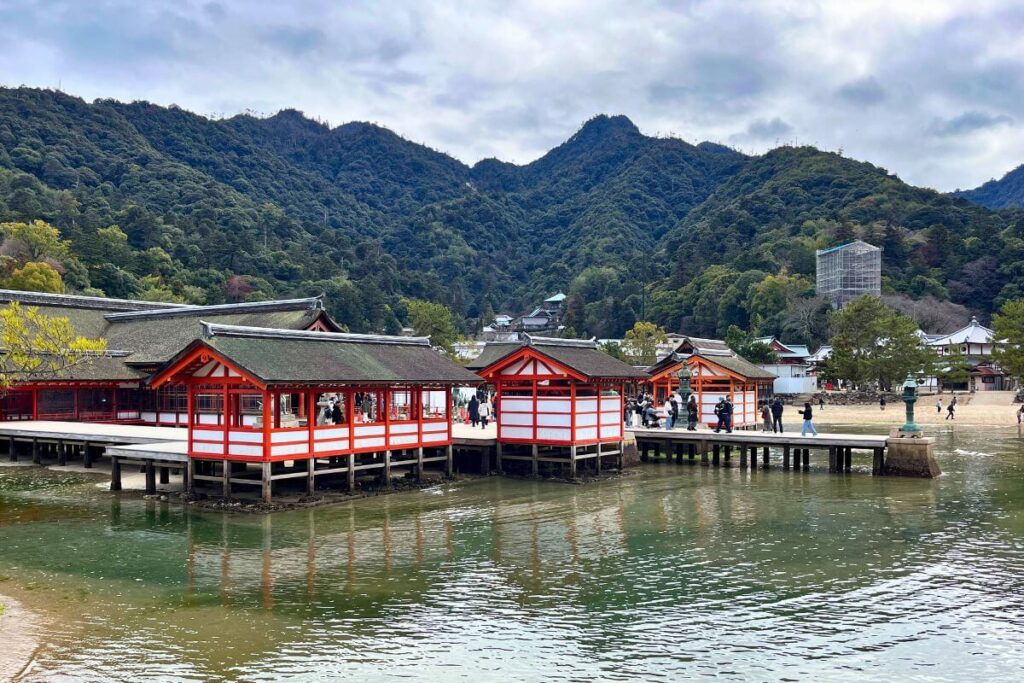
Designated as a UNESCO World Heritage Site, Itsukushima Shrine is one of the most important landmarks on Miyajima Island.
In fact, the island is officially called Itsukushima in honor of the shrine. Meanwhile, its widely known nickname, Miyajima Island, means “shrine island” in Japanese.
Dating back to the 6th century, this shrine features a vibrant red-orange complex that’s constructed on stilts along the shoreline.
As a result of this unique setting, you’ll experience will vary depending on the tides.
During high tide, the shrine appears to float amidst the waters. Meanwhile, low tide grants access to the beach, offering a close encounter with the shrine’s iconic torii gate.
Behold the Five-Storied Pagoda
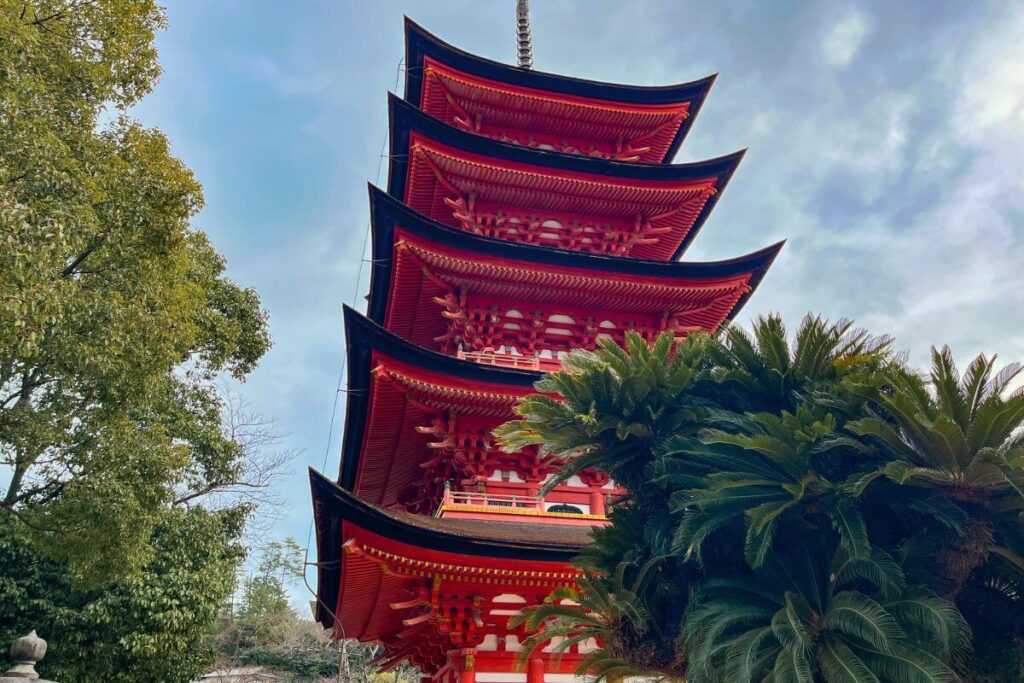
Perched atop a hill overlooking Itsukushima Shrine, Miyajima’s Five-Storied Pagoda is certainly a sight to behold!
Dating back to the 15th century, this vibrant red-orange structure was originally erected as a tribute to the Buddha of Medicine.
Today, it’s a popular tourist attraction, one that is known for its unique architectural design, which incorporates both Japanese and Chinese influences.
Situated adjacent to the pagoda, you’ll find another important structure, Hokoku Shrine, also known as Senjokaku or the Hall of One Thousand Tatami Mats.
While this Shinto shrine is unfinished, it holds the distinction of being the largest building on the island.
Take in the Views from Mount Misen Observatory
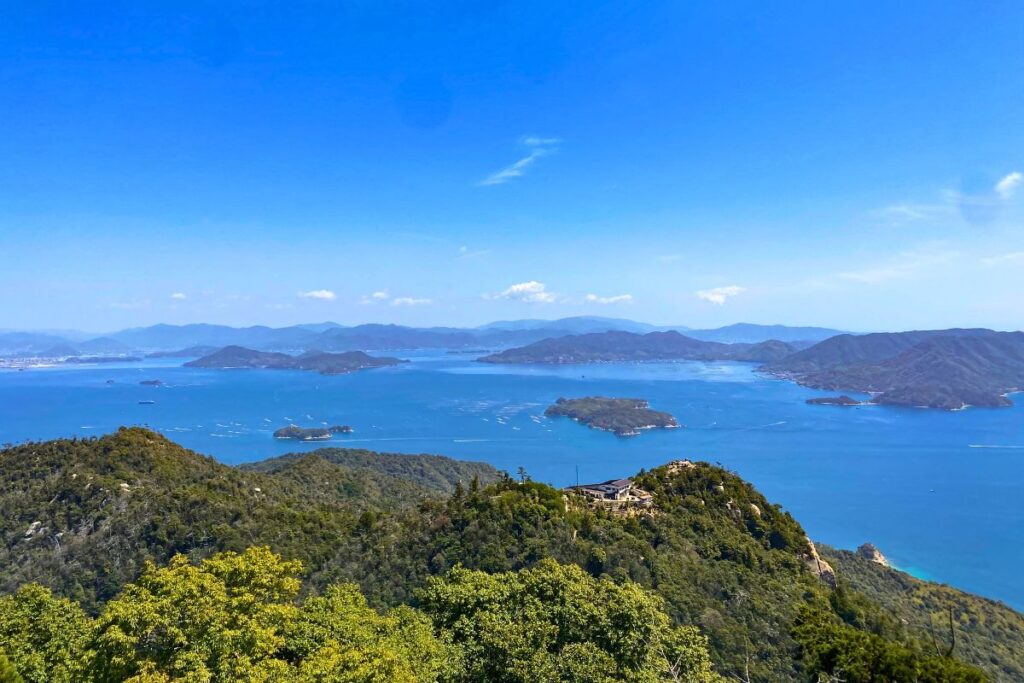
View from Mount Misen Observatory on Miyajima Island.
For the best views on the island, make your way up to Mount Misen Observatory.
Located at the top of Miyajima’s tallest peak, this observatory lies 535 meters above sea level and offers panoramic views of the island and surrounding waters.
To get here, you can either hike up the mountain or take a ride on the Miyajima Ropeway.
While travel time for the ropeway is about 15 minutes each way, hiking can take anywhere from 1.5 to 2 hours, depending upon the trail you take.
There are three trails currently open to hikers. They include Momijidani Course, Daisho-in Course, and Omoto Course.
All of them can be quite steep and strenuous. So, if you’re not already an avid hiker, it may be best to stick with the ropeway.
Pro Tip: The mountain top is full of various lookout points and attractions, so be sure to walk around and check it all out!
Explore Daisho-in Temple
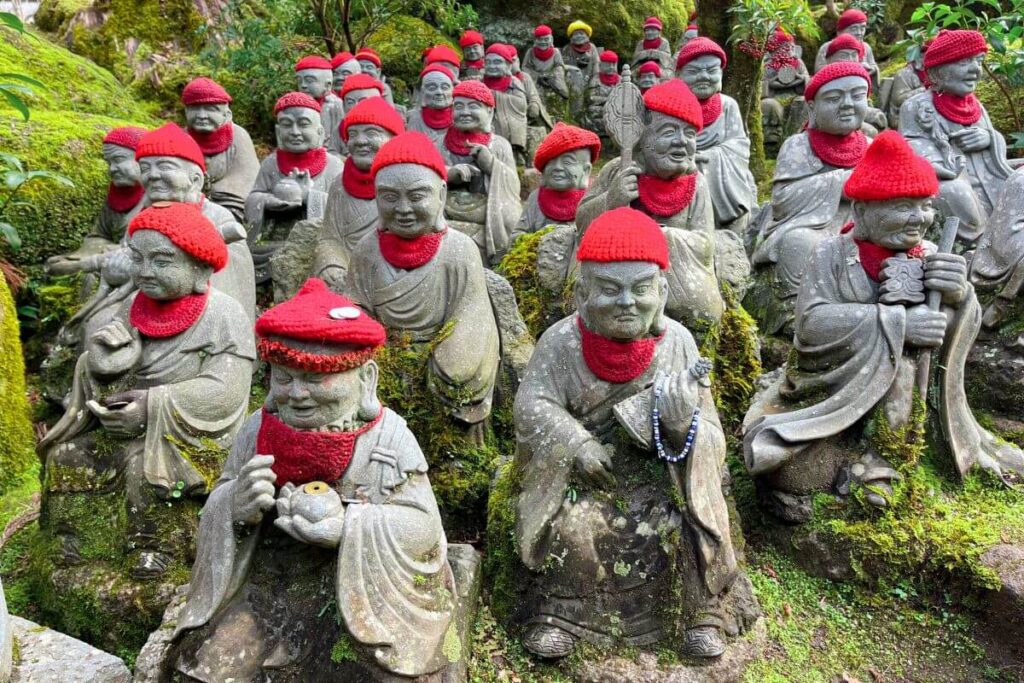
Renowned for its beautiful natural setting, Daisho-in is widely regarded as one of the most important Shingon Buddhist temples in western Japan.
Nestled at the base of Mount Misen, the temple is home to several stunning gardens, sacred statues, and traditional religious structures.
Among its treasures, you’ll find 500 miniature Buddhist statues spread throughout the grounds. Many of them are adorned with small woven hats and scarves.
Meanwhile, at the back of the property lies an enchanting cave – one that features several religious icons and hundreds of traditional lanterns.
Check Out Miyajima’s Shopping Street
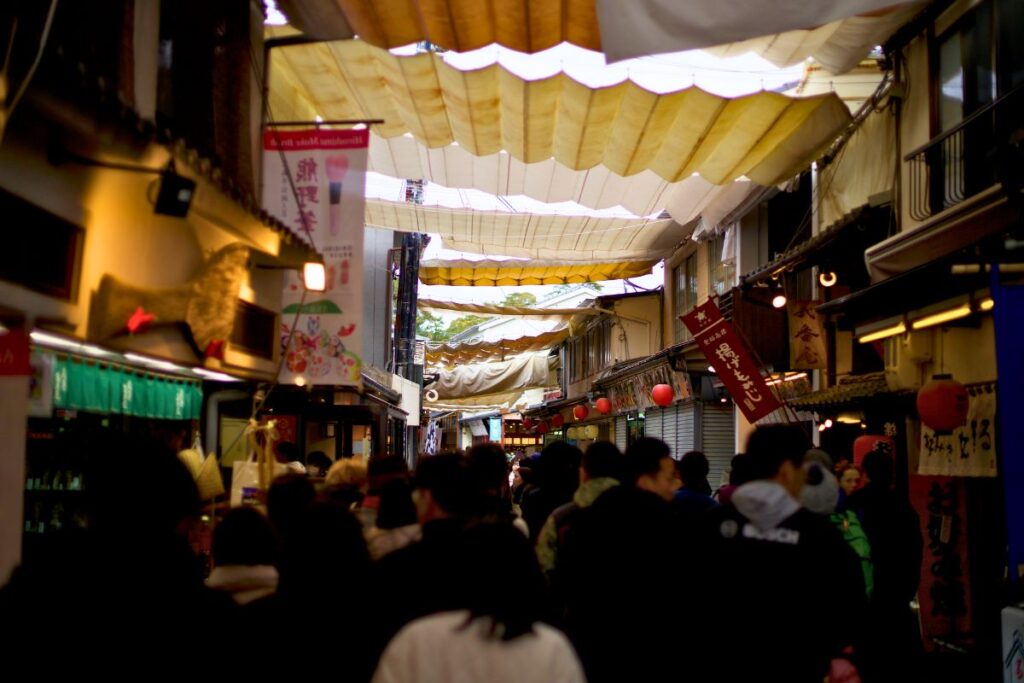
Before leaving the island, make sure to swing by Omotesando Shopping Street to pick up a few souvenirs.
Running through the center of town, this bustling road is home to an array of local shops, bars, cafes, and food stalls.
It’s an ideal spot to take a break, grab a bite to eat, and maybe even purchase a few mementos to take home.
Other Things to Do in Hiroshima
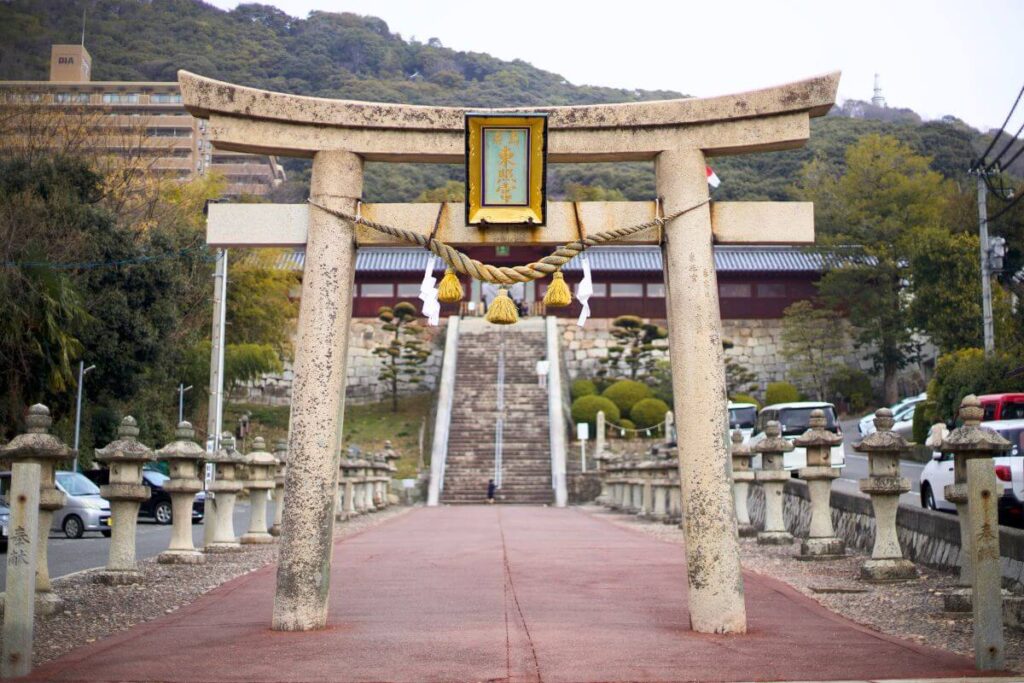
The entrance to Hiroshima Toshogu Shrine.
Interested in adjusting this Hiroshima itinerary? Or maybe you’re contemplating a longer stay? If so, consider visiting some of these other popular attractions as well!
- Hiroshima Toshogu Shrine: Dating back to the 17th century, Hiroshima Toshogu is a Shinto shrine known for its incredible views of Hiroshima. Located on a hill overlooking the city, the shrine is perfect for those looking to explore a bit off the beaten path.
- Hondori Shopping Street: Situated in downtown Hiroshima, Hondori Street is a popular pedestrian arcade street stretching approximately half a kilometer. Here, you’ll find everything from clothing stores to restaurants, cafes, gaming arcades, karaoke bars, and anime shops.
- Hiroshima Orizuru Tower: Standing 50 meters tall, Orizuru Tower offers stunning views overlooking Hiroshima Peace Memorial Park. In addition to this, the tower is also home to several cafes, a souvenir shop, and an interactive digital space.
- Mitaki-Dera Temple: Located just north of the city along the slopes of Mount Mitaki, Mitaki-Dera Temple is a Buddhist temple that dates back to the 800s. Surrounded by a lush forest, it’s known for its incredible autumn foliage.
- Wood Egg Okonomiyaki Museum: Home to a museum and showroom, Wood Egg is the place to go to learn about all things okonomiyaki. There are even cooking classes offered for those who are interested – just be sure to make your reservations in advance!
- Hiroshima Kagura: Offered from April to December, Hiroshima Kagura is a traditional Japanese performance that features sacred ceremonial dances. These dances, which were originally performed as part of Shinto rituals, feature elaborate costumes, intricate masks, and lively musical accompaniment.
Where to Stay in Hiroshima
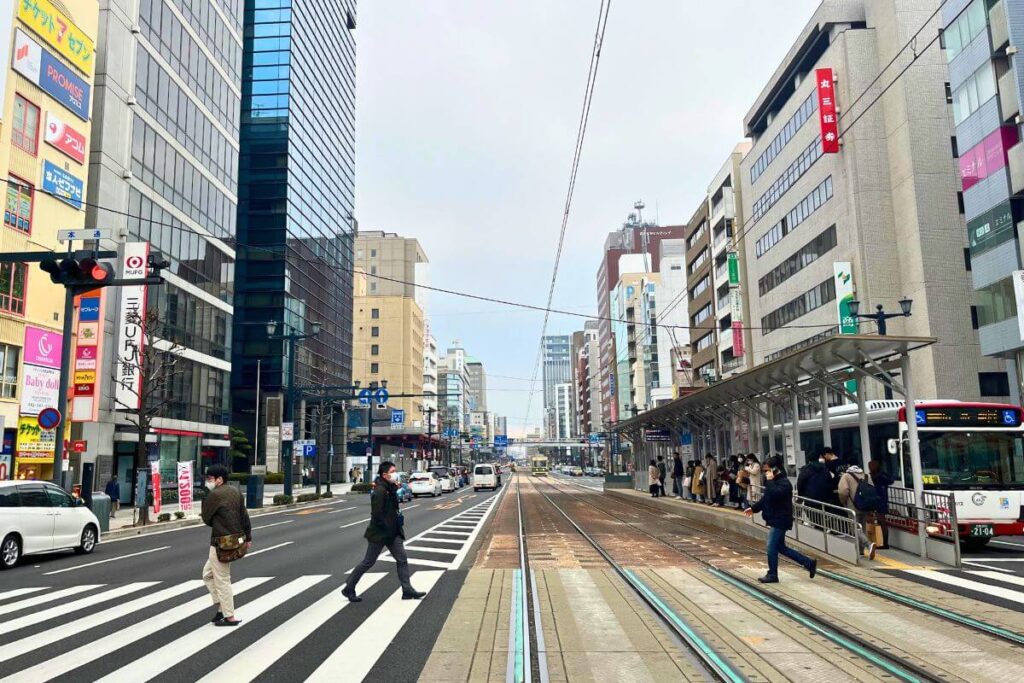
Downtown Hiroshima is a popular place to stay for travelers to the city.
As a growing tourist destination, Hiroshima offers a variety of accommodation options spread throughout the city. Where you opt to stay will largely depend on your budget, itinerary, and personal preferences. That being said, I’ve included below some of the most popular places to stay in Hiroshima for 2 days.
- Hiroshima Station: Offering the most convenience in terms of transportation, the area around Hiroshima Station is home to a variety of accommodations. Here, you’ll also find several restaurants, bars, and shopping centers.
- Hondori: Centrally located in the heart of the city, Hondori is the perfect place to stay if you’d like to be in the midst of it all. Not only is this area home to the popular Hondori Shopping Street but it’s also known for its abundant nightlife and entertainment.
- Motomachi: Situated close to Hiroshima Castle, Motomachi provides easy access to several of the city’s attractions. While this area tends to be busy during the day, it quiets down in the evenings.
What to Eat in Hiroshima & Miyajima
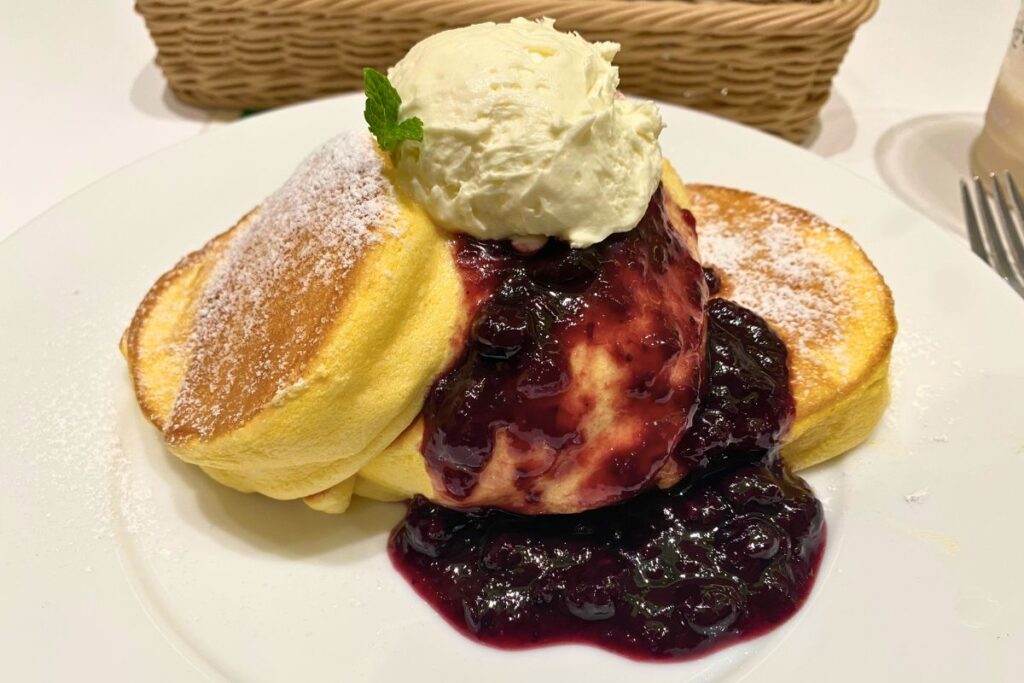
Souffle pancakes are popular throughout Japan!
While okonomiyaki is, undoubtedly, one of Hiroshima’s most famous dishes, there are a number of other delectable treats that you can try. Here are a few of the most popular!
- Souffle Pancakes: Also known as fluffy pancakes, souffle pancakes are quite popular throughout Japan and can be found at several restaurants in Hiroshima. They are typically served with a variety of fruit, sweet sauces, whipped cream, and even ice cream!
- Hiroshima Tsukemen: Sometimes referred to as “soupless ramen,” tsukemen is a noodle dipping dish that features the same noodles and toppings that you’d find in traditional ramen. The difference here is that the broth is swapped out for concentrated dipping sauce. And this sauce, at least in Hiroshima, is known to be hot and spicy.
- Oysters: Hiroshima Bay is home to a plethora of oyster farms, so it should come as no surprise to hear that oysters are quite popular in the area. You can find them served up in a variety of ways, including raw, fried, boiled, and grilled.
- Momiji Manju: A popular dessert on Miyajima Island, Momiji Manju is a cake-like treat molded into the shape of a maple leaf. It’s typically fried or baked and comes with a variety of fillings including chocolate, matcha, and custard.
- Anago-Meshi: A traditional specialty on Miyajima Island, Anago-Meshi features locally- caught conger eel that’s boiled and served on top of rice. It’s also quite popular in Hiroshima and the surrounding area as well.
Frequently Asked Questions About Visiting Hiroshima
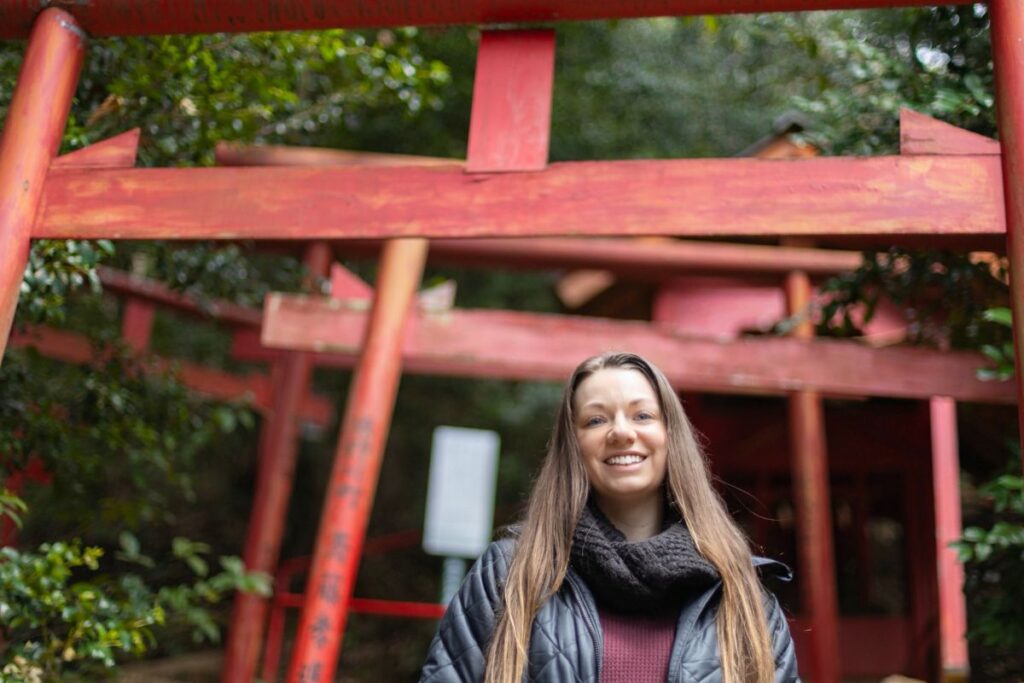
Standing under the torii gates at Hiroshima Toshogu Shrine.
Here are my thoughts on some commonly asked questions about traveling to Hiroshima.
Is Hiroshima Worth Visiting?
Yes, Hiroshima is most certainly worth visiting! It’s such a beautiful city and one that offers a wealth of opportunities and experiences. From historical sites to scenic views, unforgettable local cuisine, and a culturally rich atmosphere – there’s something for everyone here!
Is 2 Days in Hiroshima Enough?
While you could easily spend a week (if not more) exploring Hiroshima, 2 days is just enough time to hit up the city’s highlights – and take a day trip to Miyajima Island. Granted, you won’t be able to see everything, but you will at least get a feel for both destinations.
Is One Day Enough for Hiroshima and Miyajima?
While I recommend spending at least 2 days in Hiroshima and Miyajima, it’s certainly possible to visit both destinations in one day. Just keep in mind, you won’t have much time to explore either place. You’ll pretty much be limiting yourself to the major attractions. That being said, if one day is your only option, then go for it. Although, I do recommend joining a guided tour out of Hiroshima or Kyoto/Osaka, to maximize your time and experience.
Should I Stay in Hiroshima or Miyajima?
For the purposes of this itinerary, I recommend spending the night in Hiroshima. Generally speaking, it’s easier to find accommodations and transportation is more accessible in Hiroshima than it is in Miyajima. That being said, if you have extra time, it may be worth it to spend a night on Miyajima Island. While I have never done so myself, I’ve heard it’s an incredible experience, as you get to see and explore the island without large crowds.
How Long is the Ferry From Hiroshima to Miyajima?
The ferry from Hiroshima to Miyajima takes anywhere from 10 minutes to 45 minutes, depending on the route you take. There are two ferry terminals in the city of Hiroshima and one down in the nearby city of Hatsukaichi. The Aqua Net Direct Ferry, which departs from Hiroshima Peace Park, takes about 45 minutes one way. Meanwhile, the Seto Inland Sea Steamship departs from Hiroshima Port and offers travel times of approximately 30 minutes. And, lastly, the JR Ferry (which is the only one to accept the JR Pass), takes about 10 minutes. However, it does require a 30-minute train ride from Hiroshima City to Hatsukaichi.
Final Thoughts: 2 Days in Hiroshima
So there you have it – my complete guide and recommendations for 2 days in Hiroshima! Hopefully this article is helpful in planning your own trip to one of Japan’s most beautiful cities!
Regardless of what you decide to do, you’re sure to have an unforgettable time! After all, Hiroshima is an incredible destination, one that offers a unique mix of history, culture, and natural beauty.
Have you been to Hiroshima? Is there anything you’d add to this 2 day Hiroshima itinerary? Let me know in the comments below!
Enjoy this post about 2 days in Hiroshima? Pin it now for later!
